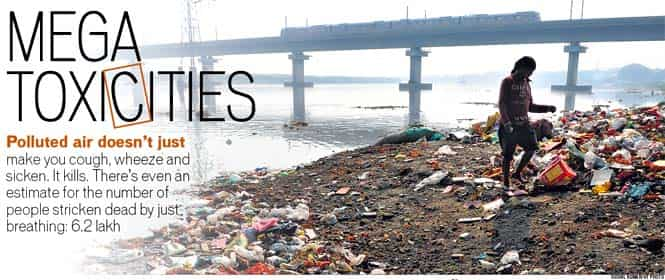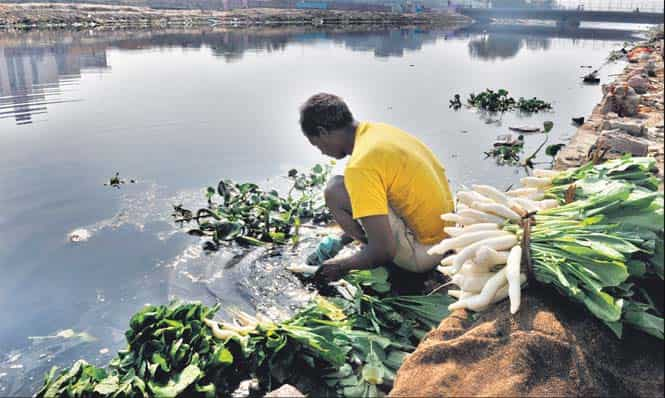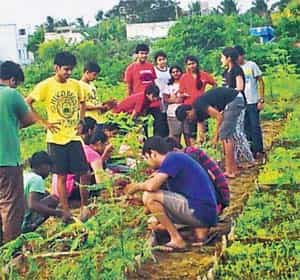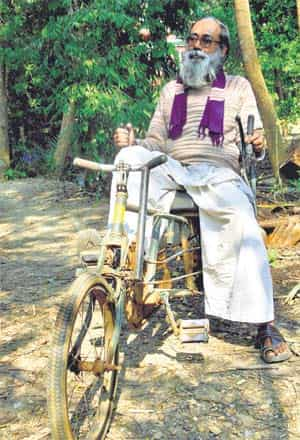How air and water pollution plagues Indian cities
Polluted air doesn’t just make you cough, wheeze and sicken. It kills. Keeping track of all the toxins that creep into our bodies through air, food and water is near impossible, but here’s a list of ones that should be avoided as much as possible.

Outdoor air pollution caused 6.2 premature deaths in India in 2010, which is a six-fold jump from the 1 lakh deaths in 2000. This makes polluted outdoor air the largest killer in India after high blood pressure, indoor air pollution (mainly from smoking chullahs), tobacco use, and poor nutrition, says the Global Burden of Disease 2013, which tracks deaths and illnesses from all causes every 10 years.
One in three people in India live in critically-polluted areas that have noxious levels of nitrogen dioxide (NO2), sulphur dioxide (SO2) and lung-clogging particulate matter larger than 10 micron (PM10) in size. Of the 180 cities monitored by India’s Central Pollution Control Board in 2012, only two — Malapuram and Pathanamthitta in Kerala — meet the criteria of low air pollution (50% below the standard).

Vehicles are the biggest air polluters. “In Delhi, for example, 1,400 vehicles are added to the roads each day and contribute to more than 70% of air pollution. Barely 20 Indian cities follow Euro4 emission standards for new vehicles, most follow Euro3. Euro4 is seven years behind European standards and Euro3 is behind by 12 years,” says Anumita Roychowdhury, research and advocacy, Centre for Science and Environment (CSE). In Delhi, one death takes place every hour due to air pollution.
Though air quality monitoring has doubled between 2005 and 2010 from 96 to 180 cities, the number of cities with low pollution has fallen from 10 to 2, while critically-polluted cities have risen from 49 to 89.
For indoor pollution, the daily permissible limit is 100 microgram per cubic metre (µg/m³) for PM10 and 60 µg/m³ for PM2.5. In many rural homes, the level is between 500 and 600 µg/m³. “We need clean-burning chullahs, especially LPG-based ones as even kerosene burning results in toxic byproducts,” she adds.Vehicles are the biggest air polluters. “In Delhi, for example, 1,400 vehicles are added to the roads each day and contribute to more than 70% of air pollution. Barely 20 Indian cities follow Euro4 emission standards for new vehicles, most follow Euro3. Euro4 is seven years behind European standards and Euro3 is behind by 12 years,” says Anumita Roychowdhury, research and advocacy, Centre for Science and Environment (CSE). In Delhi, one death takes place every hour due to air pollution.
Though air quality monitoring has doubled between 2005 and 2010 from 96 to 180 cities, the number of cities with low pollution has fallen from 10 to 2, while critically-polluted cities have risen from 49 to 89.
For indoor pollution, the daily permissible limit is 100 microgram per cubic metre (µg/m³) for PM10 and 60 µg/m³ for PM2.5. In many rural homes, the level is between 500 and 600 µg/m³. “We need clean-burning chullahs, especially LPG-based ones as even kerosene burning results in toxic byproducts,” she adds.

No one quite recalls exactly when the non-perennial natural drain across Ludhiana called Budha Dariya (river) came to be called Budha Nullah (drain), but most people who live along its banks vouch for its toxicity. So choked is the drain with industrial effluents and sewage that calcium, magnesium, fluoride, mercury, beta-endosulphan and heptachlor pesticide make both ground and tap water unfit for drinking, found a study by the Post Graduate Institute of Medical Education and Research (PGIMER) in 2008.
Compared to the other 65 wards in Ludhiana, 1.2 lakh people living in the 10 wards along Budha Nullah have much higher incidence of chronic stomach disorders, hepatitis A and cancers of the bladder, kidneys, lung, skin, colon and liver. Rickshaw-puller Sunder Lal, 50, died in October this year after battling liver cancer for two years. His wife Rano blames it on the water.
“Water is a major problem in our neighbourhood (Street-2 Gandhi Nagar) and has claimed many lives,” laments Rano. Agrees her neighbour Darshan, who was recently hospitalized for two months for hepatitis treatment: “The doctors asked me to move home or get a reverse-osmosis water filter, but I can’t afford to do either,” he said.
Pesticides, heavy metals and antibiotics leeching into the water table also find their way into our bodies through farm produce, poultry and dairy products. In the absence of Maximum Residual Limit for several crops, pesticide residues can go through the roof. “Guidelines for pesticides in farming are not stringent and many farmers don’t even know the maximum limits, they use pesticides at will to protect their crop,” says Amit Khurana, food safety and toxins, CSE. Most of these chemicals are neurotoxic and carcinogenic.

There are some trying to stem the toxic assault. All through July this year, Chandra Bhushan Tiwari, 43, gave away 11,000 saplings to people Lucknow, saying “Take ‘her’ (sapling) with you. She is my daughter getting wedded into your home. Take care of her, because she cares for people from birth to cremation.”
Tiwari has been distributing and planting saplings every monsoons since 2006. He is close to his target of planting 1 lakh trees in his lifetime, having already planted over 85,000. “I think, now when I am almost ready to attain the target, I can push it further up”, says Tiwari, a former Central School teacher, who chucked his job to take up his tree crusade full time.
VK Bharadwaj, 55, took to cycling on the busy roads of Mumbai in November 2010 for three reasons. He had crossed the age of 50 and didn’t want to be what he describes as a “low hanging fruit” for doctors, he wanted to reduce his dependence on fossil fuels, and lower expenses. “The coal crisis got me to think of wanting to reduce my carbon footprint which in turn will reduce my fuel expenses,” said Bharadwaj. “I bought a cycle for `30,000. That amounts to `1/km over three years as against `10/km had I used the car.” And he doesn’t need to stop for refuelling.
Story by Pankaj Jaiswal in Lucknow and Snehal Rebello in Mumbai
Keeping track of all the toxins that creep into our bodies through air, food and water is near impossible, but here’s a list of ones that should be avoided as much as possible

From Vehicular emissions, indoor air pollution, industry
Carbon Monoxide: From Motor vehicle exhaust, kerosene or wood burning stoves
Hazard: Headaches, reduced alertness, heart attack, impaired foetal development
Sulfur Dioxide: From Coal-fired power plants, petroleum refineries, manufacture of sulfuric acid and smelting of ores containing sulfur
Hazard: Eye irritation, wheezing, chest tightness, shortness of breath, lung damage
Nitrogen Dioxide: From vehicules, electric utilities, and other sources of burning fuel
Hazard: Rrespiratory infections, cough, chest pain, difficulty breathing
Ozone: From vehicular exhaust and fumes.
Hazard: Eye and throat irritation, cough, respiratory problems, asthma, lung damage
Particulate matter: Diesel engines, power plants, industries, windblown dust, construction dust, wood and coal burning
Hazard: Eye irritation, asthma, lung damage, heavy-metal poisoning, heart problems.
Lead: From metal refineries, lead smelters, battery manufacturing, paint
Hazard: Anaemia, high BP, brain and kidney damage, neurological disorders, cancers
Mercury: From fossil fuels such as coal, natural gas ; industrial boilers and geysers, metal refineries and cement manufacturing
Hazard: Neurological damage, extreme mood swings, insomnia, headaches, cognitive decline and, in extreme cases, kidney damage and respiratory failure


Ground and surface (rivers, lakes, ponds)
From Industrial effluents, pesticides, micro-organisms
Agriculture: From pesticides/insecticides. Organochlorines that contain carbon, chlorine and hydrogen such as DDT, heptachlor, aldrin, endosulfan etc, and organophosphates that were promoted as less toxic by the industry such as parathion, malathionHazard: Reproductive system dysfunction, birth defects. Known neurotoxins that damage nerve cells, immunity, kidneys and gene structure
Untreated sewage: From sewage, food waste and detergents. E. coli and faecal streptococci and nitrates in untreated sewage, fertilisers and manure; arsenic leechingfrom rock into groundwater water due to over-extraction.
Hazard: Water-borne diseases such as diarrhoea, dysentery, jaundice, cholera, typhoid
Industrial effluents: From factories, refineries and power and steel plants release heavy metals such as arsenic, cadmium, copper, chromium, fluoride, mercury, iron, zinc
Hazard: Arsenic causes cancers of the bladder, skin and lung; others weaken teeth and bones weaker, damage vital organs, cause allergies, intestinal lesions
Food contaminants: From pesticides, fertilisers, growth hormones, antibiotics such as tetracycline, ciprofloxacin, enrofloxacin and ampicillin given to livestock to prevent disease, accelerate growth and increase feed efficiency
Hazard: Neurotoxin that damages the nervous system, immunity, kidneys, alters genes and causes hormonal imbalances, leading to problems such as early puberty and obesity

A green network
Nalla Keerai (Good Greens)Chennai
Sankaran Srinivasan, 24, a software engineer with TCS on weekdays, and volunteers with Nalla Keerai (Good Greens), an a group promoting organic farming. over the weekends. He picks up organic produce from a centralised location, takes it to the pre-assigned point for retail distribution, collects money from customers who had already ordered online, and deposits it with Nalla Keerai. He is one of the many college students, software engineers and MNC executives, volunteering with the logistics, marketing and farming of organic produce in the outskirts of Chennai.

The heavily networked brigade is leveraging the social networking sites to build a busy “marketplace”. The Facebook page has over 6,000 likes and 2,000 regular customers. They use online order forms to post their requirements, which are sent to farming units. The fresh produce is delivered once a week on Saturdays and grain once a month to 60 different locations, from where volunteers pick up and deliver the produce.
It was R Jagannathan who came up with the idea of organic farming. Soon, S. Saravanan, Thirumalai Ranganathan and several others quit the corporate world to take to farming. “Several young people signed up as volunteers because they wanted to do something for the environment, ecology and society,” Reanganathan, who met his volunteer wife Anisha while spreading millet over a weekend.
Nalla Keerai, which now deals in 30 varieties of green leafy vegetables and 20 types of millets, has begun to make a difference. Farmers are encouraged to grow more organic varieties as there are no overheads and no middlemen. “Money is directly paid to the farmers, in advance, even before delivery,” says Reanganathan.
“We are re-introducing millets as a staple diet, for its health quotient and getting people back to their traditional staple – Nava Dhanyams.
Ranganathan wants to take this model across India, with plans underway to launch Millet Sunday in Bangalore soon. This week, he travelled to Andhra Pradesh to tie up with farmers and share his model with anyone who will see, listen and adopt. Organic produce and traditional staples have to revived, he insists, and he is willing to do the job with a little help from his friends.
Story by KV Lakshmana
Lighting up without electricity
Arani Chakravarti, 52
Shantiniketan, West Bengal

The Chakravarti home has no lights, no fans, no refrigerator, no television not even a motor pump to pump out water. “We don’t need those things. We are happy with the way we live, among nature and everything,” says Chakravarti, who lives with his wife Samita Seal and sundry strays the couple have adopted.
The couple uses three 12-volt batteries charged using a solar panel to light two small LED bulbs. They have adopted a Roman system for cooling. “We have laid ventilation ducts through a channel of water that cools the air as it enters the room. It brings the indoor temperature down by almost five-degrees, which makes it really comfortable. If we need a breeze, there is hand-fan,” smiles Seal.
The Chakravartis and their family — cats, dog, swans, ducks and Cockatiels birds — use only four to five watt of power a day. Handpumps are used to pump water into tanks and reservoir.
It was a stray cat that helped the Chakravartis choose to live like this. “When he joined Visva-Bharati in 1997, we rented a room like everyone else. But then we found an abandoned cat and brought it home, but the neighbours objected, so we decided to have a home of our own,” says Seal, who was also a professor of Physics at Suri Vidyasagar College till she resigned in April 2012.
“I recall when we first entered our new home, it was a moonlit night, with natural breeze, something we’d got used to camping for the past one year. We decided that we would continue to live like this,” she says. Seal now spends time treating strays using Homeopathy.
“When we moved in, people said you can’t go on like this. It’s been 13 years and now they appreciate it,” says Chakravarti. “It’s not easy at first, but once you get started, you love every bit of it,” he says.
Story by Surojit Ghosh Hazra
Get Current Updates on India News, Lok Sabha Election 2024 live, Infosys Q4 Results Live, Elections 2024, Election 2024 Date along with Latest News and Top Headlines from India and around the world.



